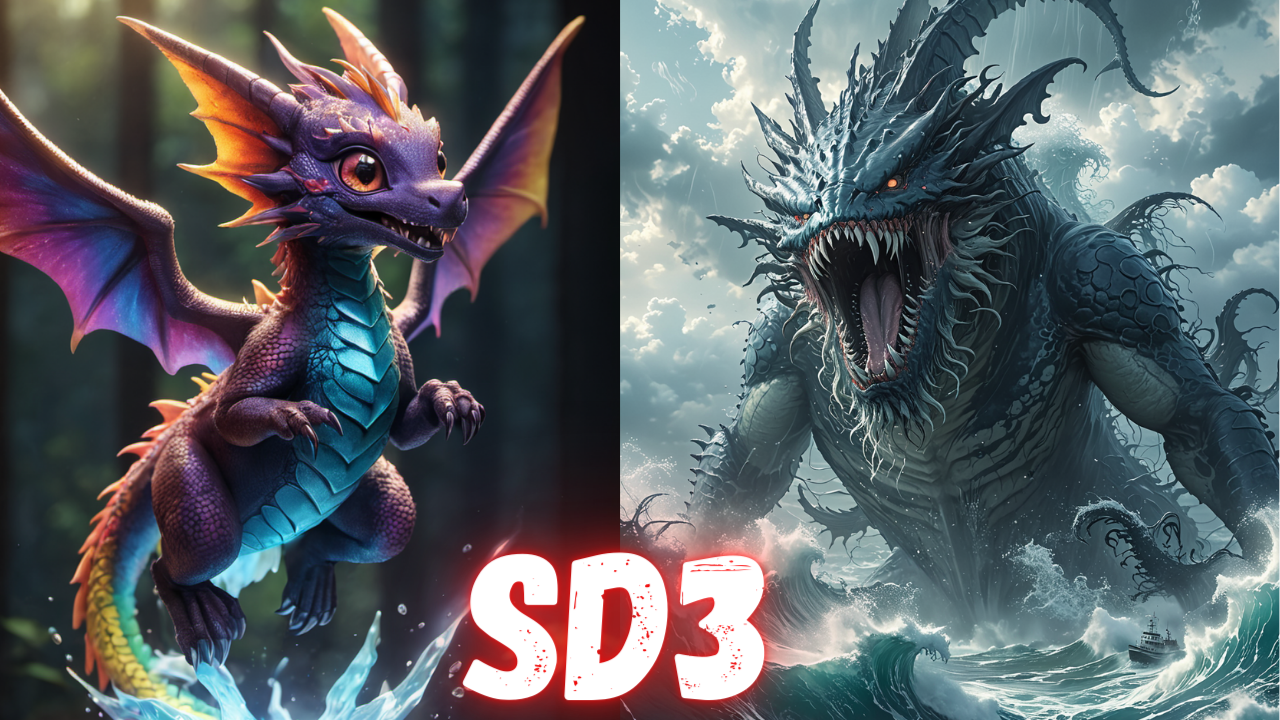Tutorial Video : https://youtu.be/XFUZof6Skkw

In this comprehensive video tutorial, I showcase the installation and usage of #SwarmUI on various cloud platforms. This guide is invaluable for those without access to high-powered GPUs or seeking to leverage additional GPU capabilities. You'll gain insights into setting up and operating SwarmUI, a cutting-edge Generative AI interface, on Massed Compute, RunPod, and Kaggle (which offers complimentary dual T4 GPU access for 30 hours per week). This walkthrough will equip you with the knowledge to utilize SwarmUI on cloud GPU providers as seamlessly as on your personal computer. Additionally, I'll demonstrate how to implement Stable Diffusion 3 (#SD3) in cloud environments. It's worth noting that SwarmUI employs the #ComfyUI backend.
🔗 Access the Public Post (no login or registration necessary) Featured in the Video, Including Relevant Links
➡️ https://www.patreon.com/posts/stableswarmui-3-106135985
🔗 Windows Tutorial: Master SwarmUI Usage
➡️ https://youtu.be/HKX8_F1Er_w
🔗 Tutorial: Rapid Model Downloads for Massed Compute, RunPod, and Kaggle, plus Swift Model/File Uploads to Hugging Face
➡️ https://youtu.be/X5WVZ0NMaTg
🔗 Join the SECourses Discord Community
➡️ https://discord.com/servers/software-engineering-courses-secourses-772774097734074388
🔗 Stable Diffusion GitHub Repository (Please Star, Fork, and Watch) ➡️ https://github.com/FurkanGozukara/Stable-Diffusion
Promotional Code for Massed Compute: SECourses
Applicable to Alt Config RTX A6000 and RTX A6000 GPUs
0:00 Introduction to SwarmUI cloud services tutorial (Massed Compute, RunPod & Kaggle)
3:18 SwarmUI installation and usage on Massed Compute virtual Ubuntu machines
4:52 ThinLinc client setup for synchronization folder access on Massed Compute VMs
6:34 Connecting to and initiating Massed Compute virtual machine usage
7:05 One-click SwarmUI update on Massed Compute pre-usage
7:46 Configuring multiple GPUs on SwarmUI backend for simultaneous image generation
7:57 GPU status monitoring using nvitop command
8:43 Pre-installed Stable Diffusion models on Massed Compute
9:53 Model download speeds on Massed Compute
10:44 Identifying GPU backend setup errors in 4-GPU configuration
11:42 Monitoring status of all active GPUs
12:22 Image generation and step speed on RTX A6000 (Massed Compute) for SD3
12:50 CivitAI API key setup for accessing gated models
13:55 Efficient bulk image download from Massed Compute
15:22 Latest SwarmUI installation on RunPod with proper template selection
16:50 Port configuration for SwarmUI connectivity post-installation
17:50 RunPod SwarmUI installation via sh file download and execution
19:47 Resolving backend loading issues through Pod restart
20:22 Reinitiating SwarmUI on RunPod
21:14 Stable Diffusion 3 (SD3) download and implementation on RunPod
22:01 Multi-GPU backend system setup on RunPod
23:22 RTX 4090 generation speed (SD3 step speed)
24:04 Rapid image batch download from RunPod to local device
24:50 SwarmUI and Stable Diffusion 3 setup on free Kaggle accounts
28:39 SwarmUI model root folder path modification on Kaggle for temporary storage
29:21 Secondary T4 GPU backend addition on Kaggle
29:32 SwarmUI restart procedure on Kaggle
31:39 Stable Diffusion 3 model usage and image generation on Kaggle
33:06 Resolving out-of-RAM errors on Kaggle
33:45 Disabling one backend to prevent RAM errors with dual T5 XXL text encoder usage
34:04 Stable Diffusion 3 image generation speed on Kaggle's T4 GPU
34:35 Batch image download from Kaggle to local device
Introduction
In this comprehensive guide, detailed instructions are provided on how to utilize SwarmUI, Stable Diffusion 3, and other Stable Diffusion models on various cloud computing platforms. The tutorial covers three main options for users who may not have access to powerful GPUs locally:
1.1 Massed Compute
Massed Compute is introduced as the cheapest and most powerful cloud server provider. The process of setting up and using SwarmUI on Massed Compute is explained in detail, including how to deploy a virtual machine, access it remotely, and generate images using multiple GPUs simultaneously.
1.2 RunPod
The second part of the tutorial focuses on how to set up and use SwarmUI on RunPod, another cloud service provider that offers access to high-end GPUs for image generation tasks.
1.3 Kaggle
For those looking for a free option, the tutorial demonstrates how to use SwarmUI on a free Kaggle account, utilizing the platform's GPU resources to run Stable Diffusion models.
Before diving into the specifics of each platform, it is emphasized that users should first watch a comprehensive 90-minute SwarmUI tutorial to understand the basic usage of the software. The current tutorial focuses primarily on installation and setup processes for cloud-based usage.
Massed Compute Setup and Usage
2.1 Registration and Deployment
To begin using Massed Compute, follow these steps:
Use the specially provided link for registration to sign up for a Massed Compute account.
After registering, enter your billing information and load some balance into your account.
Navigate to the "Deploy" section.
A special coupon code is available for RTX A6000 and RTX A6000 Alt configurations.
When selecting the configuration, users can choose between the standard RTX A6000 setup or the Alt config, which differs mainly in the amount of RAM provided. If the standard RTX A6000 is unavailable, the Alt config can be used as an alternative.
In this tutorial, four GPUs are utilized simultaneously to generate four images in parallel, though it's noted that only one GPU is necessary to run SwarmUI effectively.
To deploy a virtual machine:
Select "Creator" from the category options.
Choose "SE courses" from the image selection.
Apply the special coupon code "SECourses verify" to reduce the hourly rate from $2.5 to $1.25.
Click "Deploy" to create the new instance.
If GPUs are unavailable, users may need to reduce the number of GPUs requested for deployment.
2.2 Accessing the Virtual Machine
To access the deployed virtual machine, users need to download and install the ThinLinc client:
Download the appropriate ThinLinc client installer for your operating system from the provided link.
Install the ThinLinc client, following the standard installation process.
Launch the ThinLinc client after installation.
Before connecting to the Massed Compute virtual machine, configure the ThinLinc client:
Click "Options" in the ThinLinc client.
Go to "Local Devices" and uncheck all options except "Drives".
Click "Details" and add a folder for synchronization to enable file uploads and downloads.
Set the permissions for the synchronized folder (read-only, read and write, or not exported).
To connect to the virtual machine:
Copy the login IP address from the Massed Compute dashboard.
Paste the IP address into the ThinLinc client.
Enter the username "Ubuntu" and paste the provided password.
Click "Connect" and accept any security prompts.
2.3 Using SwarmUI on Massed Compute
Once connected to the virtual machine, users will find SwarmUI and other applications pre-installed. To ensure you're using the latest version:
Double-click the updater button on the desktop.
Wait for the automatic update process to complete.
The tutorial demonstrates how to enable multiple GPUs for parallel image generation:
Go to the "Server" tab in SwarmUI.
Navigate to "Backends".
Add additional ComfyUI self-starting backends.
Set different GPU IDs for each backend to utilize all available GPUs.
To generate images:
Select a model from the available options (e.g., StableDiffusionXL, RealVisXL, Stable Diffusion HyperRealism, or StableDiffusion3).
Choose sampling methods and other parameters.
Enter a prompt and set the number of images to generate.
Click "Generate" to start the process.
The tutorial showcases the impressive speed of image generation on Massed Compute, with multiple GPUs working in parallel.
2.4 Downloading Generated Images
To download generated images from Massed Compute:
Navigate to the files folder in the virtual machine.
Go to Apps > Stable SwarmUI > output folder.
Copy the output folder to your synchronization folder.
Access the synchronized files on your local machine.
Alternatively, users can utilize Hugging Face for uploading and downloading generated images, as explained in a separate tutorial.
2.5 Using CivitAI API
A new feature introduced after the Windows tutorial is the ability to use CivitAI API for downloading gated models:
Obtain an API key from your CivitAI account settings.
In SwarmUI, go to the "User" tab.
Enter your CivitAI API key in the designated field.
Save the changes to enable downloading of gated CivitAI models.
RunPod Setup and Usage
3.1 Registration and Deployment
To use SwarmUI on RunPod:
Use the provided registration link to create a RunPod account.
Set up billing and load credits into your account.
Navigate to the "Pods" section and click "Deploy Pod".
Choose "Community Cloud" for temporary storage or refer to the tutorial on permanent network storage if needed.
Select "Extreme Speed" from the filters.
Choose NVME storage and select the desired RAM and GPU configuration.
For the template, it's crucial to select "RunPod PyTorch 2.1 with CUDA 11.8" as it supports all necessary applications.
3.2 Installing SwarmUI on RunPod
After deploying the pod:
Connect to JupyterLab using the provided link.
Upload the "install_linux.sh" file from the official repository (modified for RunPod).
Open a terminal in JupyterLab.
Run the provided commands to clone and start the SwarmUI installer.
The installation process is relatively fast, and users don't need to wait for a template to load.
3.3 Using SwarmUI on RunPod
Once the installation is complete:
Access the SwarmUI interface through the provided HTTP service port.
Go through the initial setup process, selecting your preferred template and settings.
For model management, use the utilities section to download additional models as needed.
The tutorial demonstrates how to add multiple backends to utilize all available GPUs and generate images using various Stable Diffusion models.
3.4 Downloading Generated Images
To download images generated on RunPod:
Use the JupyterLab interface to navigate to the SwarmUI output folder.
Download the entire folder as an archive or use alternative methods like Hugging Face upload or RunPodCTL, as explained in separate tutorials.
Using SwarmUI on a Free Kaggle Account
4.1 Setting Up Kaggle
To use SwarmUI on a free Kaggle account:
Register for a free Kaggle account and verify your phone number.
Download the provided Kaggle notebook file.
Create a new notebook on Kaggle and import the downloaded file.
Select GPU T4 x2 as the accelerator to use both available GPUs.
4.2 Installing SwarmUI on Kaggle
Follow these steps to set up SwarmUI:
Execute the cells in the notebook to download models and install SwarmUI.
Follow the provided link to access the SwarmUI installer interface.
Go through the installation process, selecting your preferred settings.
4.3 Configuring SwarmUI for Kaggle
After installation:
Go to the server configuration in SwarmUI.
Change the model root to "/kaggle/temp" to utilize the temporary disk space.
Save the changes and restart SwarmUI using the provided notebook cells.
4.4 Using SwarmUI on Kaggle
Once configured:
Access the SwarmUI interface using the provided link.
Select models and generate images as demonstrated in the tutorial.
Be aware of RAM limitations when using multiple GPUs with certain models like Stable Diffusion 3.
4.5 Downloading Generated Images from Kaggle
To download your generated images:
Use the provided notebook cell to zip all generated images.
Refresh the file list in the Kaggle notebook interface.
Download the generated zip file containing all your images.
Additional Information and Resources
5.1 SwarmUI Tutorial
The tutorial emphasizes the importance of watching a comprehensive 90-minute SwarmUI tutorial before attempting to use the software on cloud platforms. This tutorial covers:
Detailed usage instructions for SwarmUI
How to use various Stable Diffusion models (SD 1.5, SDXL, SD3)
90 chapters of in-depth information
5.2 GitHub Repository
Users are encouraged to engage with the SwarmUI GitHub repository:
Star the repository to show support
Fork the repository for personal modifications
Watch the repository for updates
Consider sponsoring the project
5.3 Community Resources
The tutorial promotes joining the Discord server, which has over 7,000 members, for additional support and discussion. Even non-Patreon supporters are welcome to join and ask questions.
5.4 Patreon Exclusive Content
A Patreon exclusive post index is available on GitHub, allowing users to browse and access additional content if they choose to become supporters.
Conclusion
This comprehensive guide provides detailed instructions for using SwarmUI and various Stable Diffusion models on three different cloud computing platforms: Massed Compute, RunPod, and Kaggle. Each platform offers unique advantages:
Massed Compute provides a cost-effective solution with powerful GPUs and easy setup.
RunPod offers flexibility and high-performance options for users requiring more control.
Kaggle presents a free alternative for those looking to experiment without financial commitment.
By following this tutorial, users without access to powerful local GPUs can leverage cloud resources to generate high-quality images using state-of-the-art AI models. The guide emphasizes the importance of understanding SwarmUI basics through the recommended 90-minute tutorial before diving into cloud-based setups.
The tutorial also highlights recent updates, such as the integration of CivitAI API for accessing gated models, and provides various methods for downloading generated images across different platforms.
Overall, this guide serves as a comprehensive resource for both beginners and experienced users looking to harness the power of cloud computing for AI-driven image generation using SwarmUI and Stable Diffusion models.

